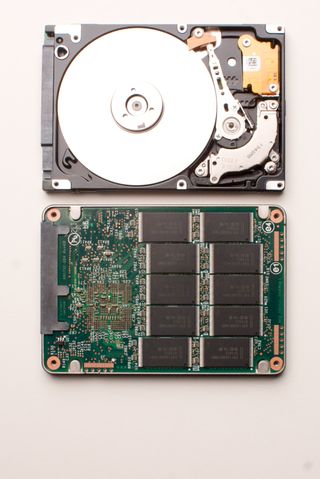Solid State Drive Buyer's Guide
Should you consider upgrading to a solid state drive? Weigh all the pros and cons and evaluate the cost and value of doing so by reading this guide.
Drive Tech Compared
So in one corner, we have hard disks with several critical moving parts, and in the other corner we have SSD with absolutely zero moving parts. All an SSD has to do is move electrons around. As you might expect, this has serious ramifications on several fronts. First off, there’s the time it takes to access any given bit of data within the drive. Even a late model, high-performance unit like Seagate’s Momentus 7200.4 notes an average “latency” of 4.17 milliseconds (ms). The latest Intel X25-M drive (using 34 nm NAND, see below) specifies 75 microseconds. You’ve got three decimal places between milli and micro, so 75 microseconds is 0.075 milliseconds, or a 55X difference between the two access times. When you’re dealing with lots of little data seeks, those gaping latency differences add up in a hurry.
Aside from that, SSD is often just flat out faster. Even the chart-topping Momentus 7200.4 tops out with an average sustained transfer speed around 80 MB/sec. Meanwhile, the latest SSDs can easily average more than 250 MB/sec on streaming read throughput. Now, when it comes to writing to the drive, SSD loses a lot of its advantage. SSDs still remain generally faster than HDDs on writes, but there are plenty of break-even cases as well as applications (video editing for one) in which hard drives keep an advantage.
As you might suspect, "reads" refer to reading data from the drive, copying it from the drive into system memory, while "writes" occur when writing data from the system out to the drive.

Because there are no moving parts, SSDs consume very little power. A power-efficient notebook drive such as Western Digital’s Scorpio Black draws 0.2W in standby mode and 2.1W when active. Intel’s latest X25-M SSDs consume only 0.15W when active and a nearly comatose 0.075W when idle. There are ways to minimize hard drive power consumption, such as running in at slower rotation speeds unless more performance is needed, but this is almost splitting hairs. SSD simply consumes less power, and that can translate into longer battery times in notebooks.
With less delicate innards, SSDs are also more rugged than their HDD counterparts. Take a unit such as Super Talent’s UltraDrive GX, which, like many modern SSDs, sports a shock resistance of 1500G, 0.8 ms. A 1500G shock is roughly equivalent to a 27-foot drop, and the 0.8 ms notes the time delay between shock pulses. In contrast, a laptop HDD such as Hitachi’s Travelstar 7K500 boasts a shock resistance of 400G during operation, meaning while the drive is in the process of reading or writing. This is the number that’s important for times when a heavy object might accidentally fall on the system while it’s active.

Sign up to get the BEST of Tom’s Guide direct to your inbox.
Upgrade your life with a daily dose of the biggest tech news, lifestyle hacks and our curated analysis. Be the first to know about cutting-edge gadgets and the hottest deals.
Current page: SSD Pros and Cons - Read, Write Speed vs. HDD - Tom’s Guide
Prev Page How SSD Works vs. Traditional Hard Drives (HDD) - Tom’s Guide Next Page SLC vs. MLC - NAND Flash Memory Performance - Tom’s GuideWilliam Van Winkle is a freelance editor and tech journalist who has been writing for more than 20 years. His work has appeared on Tom's Guide, Tom's Hardware, Tom's IT Pro, AMD, Seagate, Computer Shopper, and more. He is also an author, writing poetry, short stories, and science fiction and fantasy books.
-
Shadow703793 Imo, I'd keep away with any SSD drive using a JMicron. Dosen't matter if the stutering,etc issues were fixed. Indylinx and Intel controllers are the best right now.Reply
Anyways, I got an X25-M G2 (OEM) for $220 @Newegg during Black Friday. -
grimjester The point about getting a small SSD for software and a larger disk for data can't be stressed enough. The price per GB looks completely different if you only need 64G. There's little difference in price between the cheapest hard drive you can get and the cheapest 500G one.Reply
An SSD is just an extra cost of $150-300. It has no practical effect on the storage space your computer has. -
Eggrenade I wouldn't say it's better than Anandtech's; there's no mention of random reads or writes, which is why performance just after startup is so good. It's also a lot less technical, which is probably better for most Tom's Guide readers.Reply -
Tomsguiderachel EggrenadeI wouldn't say it's better than Anandtech's; there's no mention of random reads or writes, which is why performance just after startup is so good. It's also a lot less technical, which is probably better for most Tom's Guide readers.Exactly :)Reply -
Tomsguiderachel nonxcarbonxThis is an even better ssd article than anandtech's ssd anthology. Nice work.Thank you. I hope it was a good fit for Tom's Guide readers' needs.Reply -
Next page broken http://www.tomsguide.com/us/ssd-value-performance,review-1455-11.html, sorry couldnt find anywhere to submit feedback. Page not working on firefox 3.5.5 (does not scroll).Reply
-
Tomsguiderachel none007Next page broken http://www.tomsguide.com/us/ssd-va 55-11.html, sorry couldnt find anywhere to submit feedback. Page not working on firefox 3.5.5 (does not scroll).I'm using the same browser and that page works for me. I will report the bug, thanks.Reply -
Tomsguiderachel TomsguiderachelI'm using the same browser and that page works for me. I will report the bug, thanks.Oh--I see that you mean the final page of the article not the penultimate page. FYI There is no content on that last page so you didn't miss part of the article.Reply -
tommysch I think Ill stick to my 4x1TB RAID 0 array for now. BTW they are ghosted each week. o_0Reply
